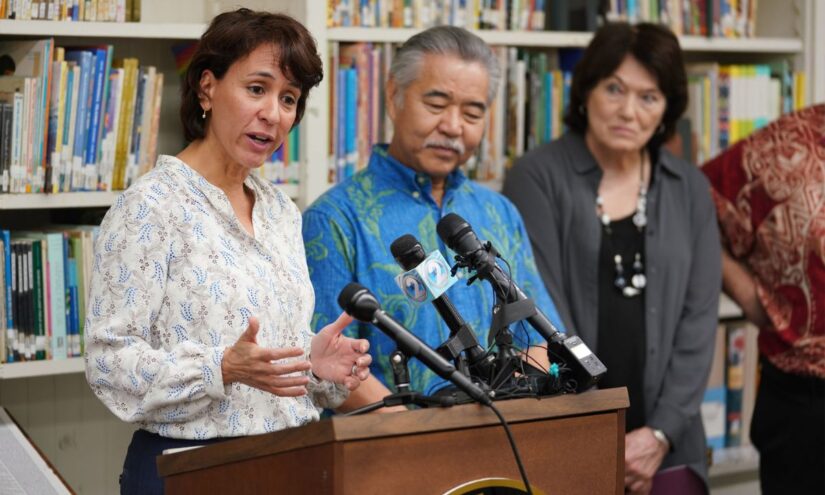Reflecting on the tenets that shape our educational practices is fundamental for …
Hawaii Working to Enhance Career-Based Learning with Increased Need for Teachers
Carlos Changemaker

Around 500 educators are set to receive bonuses of up to $8,000 this month, with some educators expressing doubts about whether this will alleviate Hawaii’s shortage of career technical education teachers.
The state’s career technical education (CTE) teachers are responsible for courses ranging from broadcast media to engineering in middle and high schools statewide. These classes focus on hands-on learning and projects to equip students with practical skills for their future careers.
While CTE has been present in Hawaii for some time, it has gained momentum in recent years, particularly under the guidance of Department of Education Superintendent Keith Hayashi. However, the expansion of CTE offerings in schools is outpacing the availability of teachers due to low salaries and licensing challenges.
The Department of Education does not formally track the shortage of CTE teachers, but an estimated 25 positions remain unfilled for the upcoming 2024-25 school year. According to the Hawaii State Teachers Association, approximately half of the CTE classes in the state are taught by instructors without the required subject area licenses.
Hawaii currently licenses educators in six CTE areas: arts and communication, business, health services, industrial and engineering technology, public and human services, and natural resources.
To address the shortage, the Department of Education is providing one-time bonuses ranging from $2,500 to $8,000 to CTE teachers based on their qualifications. Furthermore, legislation has been passed to ease teacher licensing requirements, allowing individuals with relevant work experience and high school diplomas to qualify for a CTE teaching license.
Kimberly Saula, the vice principal of Farrington High School, is optimistic that these measures will help bolster Hawaii’s CTE teacher workforce. However, she acknowledges the challenge of persuading experienced professionals in fields like healthcare or auto mechanics to transition to teaching high school students.
“The Shortage Is Huge”
After working in tourism and hotel management for a decade, Keala Swain shifted careers to teach CTE classes in computer science and information technology at Waimea High School in Kauai. Swain highlighted the significant pay cut he experienced upon entering the teaching profession, demonstrating the financial challenges faced by industry professionals transitioning to teaching.
The shortage of CTE teachers is evident, as schools struggle to attract industry experts who may face substantial salary reductions when entering education. Waimea High School Principal Mahina Anguay shared the story of losing a CTE teacher to a higher-paying position at a Navy base, emphasizing the financial disparities between teaching and industry jobs.
The licensing process for CTE teachers can be lengthy and complicated, potentially deterring prospective educators. According to Erin Yagi, who oversees Leeward Community College’s CTE licensure program, individuals must demonstrate relevant experience and complete several semesters of coursework to prepare for teaching.
One of the challenges is balancing full-time employment with the demands of the licensure program, as many aspiring CTE teachers are working adults juggling various responsibilities.
Leeward Community College is among the institutions in Hawaii offering programs to prepare teachers for CTE licensure. In the previous academic year, the college recommended 10 students for licensure.
Some Hawaii schools, like Baldwin High School, are directly affected by the teacher shortage as they expand their CTE offerings. Principal Keoni Wilhelm aims to establish a wall-to-wall academy by 2025, providing students with focused pathways in culinary arts, business, and other fields. However, recruiting teachers has been challenging, with examples of pathways being dissolved due to the inability to find replacements for departing staff.
“It’s not for a lack of trying to recruit,” Wilhelm emphasized.
Potential Reforms On The Way
Following the announcement of bonuses for CTE teachers by the Department of Education, Keala Swain was surprised by the extra financial support but questioned whether these incentives are sufficient to attract more individuals to teaching.
The use of monetary incentives to address teacher shortages is not new in Hawaii, with previous bonuses introduced for special education and Hawaiian immersion teachers, as well as educators in hard-to-staff areas.
While bonuses initially improved recruitment and retention, skepticism remains regarding the effectiveness of one-time payments in addressing the ongoing CTE teacher shortage.
In the state supplemental budget, legislators have allocated $2.5 million for continued CTE bonuses in the next school year, pending the governor’s approval.
Andrea Eshelman of the Hawaii State Teachers Association expressed doubt about the long-term impact of these bonuses in attracting and retaining CTE teachers.
Recent legislative efforts, such as Senate Bill 2257, aim to facilitate the transition of industry workers to teaching by expanding licensure eligibility criteria to individuals with relevant industry experience and a high school diploma.
Felicia Villalobos, executive director of the Hawaii Teacher Standards Board, noted that not all trades require a college degree, indicating potential for industry workers to fill teaching roles with adjustments to licensing requirements.
If the bill is enacted, individuals seeking licensure may need to complete coursework on education principles and teaching, in addition to meeting industry experience benchmarks defined by the Board.
Gov. Josh Green is expected to make decisions on pending bills by July 10.
Dante Casillas, a building and construction teacher at Waimea High School, highlighted the rewarding experience of teaching CTE classes and the impact students have on their school community through practical projects.
“The kids are just proud of their work,” he shared.
Civil Beat’s education reporting is supported by a grant from Chamberlin Family Philanthropy.



